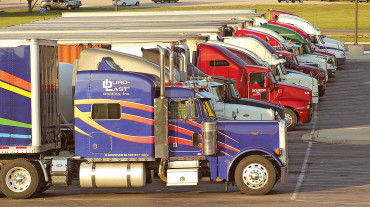How to keep drivers happy

The trucker shortage is everyone’s problem. The lack of drivers is causing the prices of nearly everything to go up, whether it’s your grocery bill, your business expenses or, perhaps worst of all, your Amazon Prime membership.
It’s all because shipping demands are rising in tandem with driver vacancies. For large carriers, this means a driver turnover rate as high as 94% while shipping demand, particularly for spot freight loads, is booming.
Recruiting and attracting qualified drivers is tougher than it’s ever been, yet the American Trucking Associations estimates the industry will need to hire nearly 900,000 additional drivers within the next decade to meet demands. In the meantime, significant portions of fleets are sitting empty in truckyards across the U.S. and beyond.
All this despite the fact that driver wages have grown significantly in the last few years—over 11% in 2018 compared to average wage growth of 1% in other sectors. Some carriers are offering bonuses worth tens of thousands of dollars, yet those incentives aren’t working.
But if a solution can be found, it would not only address one of the biggest worker shortages in today’s labor market, but a vast majority of the logistics problems present in the supply chain.
Here are three ways I think we might address the trucker shortage in North America:
1. Rebuild loyalty
Why are truckers leaving good-paying jobs? The truth is that carriers, especially large ones, are having a hard time inspiring loyalty. And they’ve got to come to terms with that in order to course correct. To do so, they’ll have to rebuild driver trust from the ground up.
Truckers today are able to jump from one carrier to the next, often spurning full-time employment for contract or freelance work. What they lose in consistency they more than make up for with a bigger paycheck—or at least that’s what their behavior suggests.
It’s hard to keep jumping around. Offering predictable, reliable work can go a long way toward earning loyalty—but only if you respect and honor it. That means if you’ve set a schedule, stick to it and don’t tack on extra work. Honor drivers’ requests for time off. These are real people with families and friends and hobbies. When they tell you that they need Saturdays off, do everything you can to give them Saturdays off.
Drivers often cite the rough lifestyle of trucking as one of the main reasons they quit. Doing whatever you can to improve that lifestyle—like respecting their time—will go a long way toward rebuilding loyalty.
2. Find better ways to pay drivers quickly
There are companies that have built massive businesses by offering a version of payday loans specific to the trucking industry—taking cuts as large as 20% in the process.
Why is there a market for a product that’s so bad for a driver’s bottom line? Because of an industry-wide outdated payment model.
Many shippers or carriers won’t provide payment for 30 to 60 days, and when they do, they often cut a physical check. It’s time to modernize these systems so that drivers are getting paid quickly—within days, not weeks or months—and digitally, so they have immediate access to the funds. Find ways to offer easy, quick payment, and it’s likely you’ll ultimately be able to pay quality drivers a little less than the competition while still reducing turnover.
3. Implement technology with humans in mind
It’s easy to point to technology as a savior. But the truth is that adding more tech isn’t going to solve anything unless it’s done with humanity in mind.
When implementing new tech, the first question you should ask is: What human problem am I solving? If new analytics software is going to make it easier to not only optimize shipments but also allow drivers to get extra time off, you’re on the right track. If you’re just adding something because it looks slick or it only benefits you, then you need to take a step back.
There are all kinds of ways to introduce new technology that will improve your bottom line, but if it’s not being done with the long-term goal of retaining and attracting quality drivers, the problem will just continue to grow. The revenue bump will be short-lived, prices will continue to rise, and drivers will keep quitting, which will ultimately cost more in time, money and energy than was ever previously gained.
The trucker shortage can be solved, but the answer is not limited to a little extra cash.
